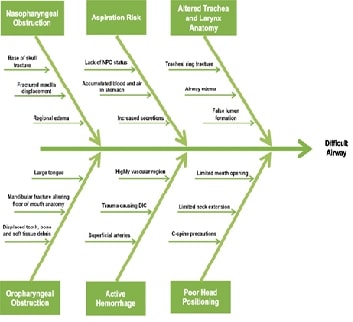Anaesthetic Management of A Patient with Pan Facial Trauma with Restricted Mouth Opening Posted for Open Reduction and Internal Fixation of Facial Bone Fractures

Abstract:
Airway management of patients with maxillofacial
trauma remains a challenging task for an anaesthesiologist in emergency and
perioperative settings due to anatomical distortion. Appropriate planning and a
team based approach is mandatory for establishing the airway during elective
surgical procedures and in postoperative period. Here we report a 24 year old
male with alleged history of road traffic accident who sustained injury to
face. Patient had restricted mouth opening of 1 finger breadth due to pain and
multiple facial bone fractures. Patient was posted for Open reduction and
Internal fixation of facial bone fractures. In view of anticipated difficult
intubation airway management was discussed as team and planned. In OR, before
induction, USG guided bilateral maxillary and mandibular block was given, which
improved patient’s mouth opening. This approach facilitated easy intubation and
thereby avoiding airway related complication.
The tube was fixed submentally so as to allow good intraoral work space
for the surgeons. This case report suggests that use of USG guided maxillary
and mandibular blocks facilitated in airway management in this patient with
restricted mouth opening. Proper preemptive planning for difficult airway cases
and multimodal analgesia helps in managing facial trauma cases successfully
without complications.
References:
[1].
Kovacs, G., & Sowers, N. 2018,
Airway management in trauma. Emergency Medicine Clinics of North America,
36(1), 61–84.
[2].
Saini, S., Singhal, S., &
Prakash, S. 2021, Airway management in maxillofacial trauma. Journal of
Anaesthesiology, Clinical Pharmacology, 37(3), 319–327.
[3].
Nordquist, D., & Halaszynski, T.
M. 2014, Perioperative multimodal anesthesia using regional techniques in the
aging surgical patient. Pain Research and Treatment, 2014,
902174.
[4].
Barak, M., Bahouth, H., Leiser, Y.,
& Abu El-Naaj, I. 2015, Airway management of the patient with maxillofacial
trauma: Review of the literature and suggested clinical approach. BioMed
Research International, 2015, 724032.
[5].
Dhanrajani, P. J., & Jonaidel,
O. 2002, Trismus: aetiology, differential diagnosis and treatment. Dental
Update, 29(2), 88–92, 94.
[6].
Kassam, K., & Messiha, A. 2014,
Fractured zygomatic arch: a traumatic cause for trismus. BMJ Case Reports,
2014(apr03 1), bcr2013202633.
[7].
Kojima, Y., Sendo, R., Ohno, S.,
& Sugimura, M. 2020, Ultrasound-guided inferior alveolar nerve block for
trismus during dental treatment: a case report. JA Clinical Reports, 6(1),
94.
[8].
Heard, A. M. B., Green, R. J.,
Lacquiere, D. A., & Sillifant, P. 2009, The use of mandibular nerve block
to predict safe anaesthetic induction in patients with acute trismus. Anaesthesia,
64(11), 1196–1198.
[9].
Jain, G., Yadav, G., Singh, A. P.,
Singh, Y., & Singh, D. K. 2016, Efficacy of ultrasound-guided mandibular
block in predicting safer anesthetic induction. Anesthesia, Essays and
Researches, 10(2), 184–188.
[10].
Shetty, P. M., Yadav, S. K., &
Upadya, M. 2011, Submental intubation in patients with panfacial fractures: A
prospective study. Indian Journal of Anaesthesia, 55(3), 299–304.
[11].
Borba, A. M., Porto, A. N., Santini,
A., Santos, T. I. dos, Miloro, M., Borges, A. H., & Pedro, F. L. M. 2018,
The effect of facial fractures on mouth opening range: a case series. RSBO,
1(3), 142.
[12].
Kumita, S., Murouchi, T., &
Arakawa, J. 2017, Ultrasound-guided maxillary and inferior alveolar nerve
blocks for postoperative analgesia in gnathoplasty. Asian Journal of
Anesthesiology, 55(4), 89–90.
[13].
Sola, C., Raux, O., Savath, L.,
Macq, C., Capdevila, X., & Dadure, C. 2012, Ultrasound guidance
characteristics and efficiency of suprazygomatic maxillary nerve blocks in
infants: a descriptive prospective study: Ultrasound-guided suprazygomatic
maxillary nerve block. Paediatric Anaesthesia, 22(9), 841–846.

